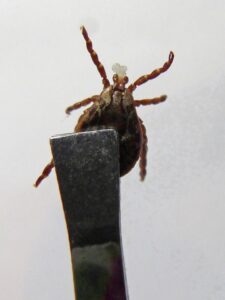If your pet becomes affected by parasites then it can make him very sick, and in some cases even cause death. Although this sounds frightening, there are ways that you can reduce the risk of your pet becoming ill because of parasite problems. The type of parasites that might affect your pet depends largely on the environment around you, so it is useful to be aware of where your pet spends time to help you be prepared.
Here is our guide to common pet parasites and how you can prevent them.
Fleas
Typically fleas can be found inside your home. Each flea can lay 30 or more eggs every single day; which then drop into your carpet ready to hatch as soon as it is warm enough and a willing host wanders by!
Fleas prefer warmer temperatures of between 65-80 degrees, and humidity levels of 75-85% so while for some states they may only be a summer problem, in others you may find your pet can be affected by fleas at any time of the year.
Transmission of fleas
In the majority of cases, fleas are passed via pet to pet contact or caught from an existing flea problem within the home. Once bitten by a flea your pet will suffer from mild to moderate itching. However, if your pet is sensitive or allergic then you may find he has severe itching that causes hair loss, inflammation or skin infections.
Diagnosing Fleas
Diagnosing fleas is relatively simple as they can usually be seen in the fur on the surface of the skin. They are a dark copper color and about the size of a pin head and they are most commonly spotted in the darkest areas on your pet as they dislike the light. You may also see ‘flea dirt’ which looks like pepper on the surface of the skin, but is actually flea feces which are made up of blood. If you still aren’t certain if your pet has fleas, pull a few off and put them on a wet piece of paper. If they spread out like a blood stain you can be pretty sure your poor pet has fleas!
Treating Fleas
In warm climates flea treatment is a year round responsibility, but if you live in a cooler state then you should start flea prevention in the spring. Your veterinarian or veterinary pharmacist will be able to advise you of the best flea preventative to suit your pet’s needs as there are a large variety available.
Other steps you can take include regularly cleaning your pet’s bedding and vacuum regularly. When you vacuum you should seal and discard the vacuum bags as soon as they are finished, and clean your home thoroughly with a veterinary recommended spray.
Worms
There are a number of different worm parasites that could affect the health of your family as well as your pet. These include but are not limited to tapeworm, roundworm, lungworm and heartworm.
Transmission of Worms
Worms are typically transmitted through contact with other infected pets (often by ingesting worm larvae or eggs found in the feces of other pets), or from eating raw meat, infected parasites or other infected prey animals.
Diagnosing Worms
Even healthy looking animals can carry worms so it is important to worm pets regularly as otherwise symptoms may not arise until it is too late. If your pet is infected then you may see worms in your pets feces or vomit, or around their bottom. If you do spot any worms you should take a sample which you should wrap in damp cotton wool or paper towels and take them to your vet as soon as possible.
Other possible symptoms include weight loss, loose bowels, muscle weakness, an increased appetite and your pet’s fur may become very dry and coarse. In extremely severe cases some pets have been known to suffer from a distended stomach.
Treating Worms
It is crucial that you participate in an active worm control program, and pets should be wormed against roundworm from a young age. Adult pets should regularly be wormed against roundworms and tapeworms. Your veterinarian will be able to advise you on the best course of worming for your pets.
You can also help prevent tapeworms by using a flea treatment, as this will stop the spread of tapeworm eggs via flea infestation.
Excellent home hygiene is important too. Water bottles and food bowls should be washed and disinfected daily and your home surfaces should also be cleaned using an animal-friendly disinfectant. Remember to clean up any pet feces immediately and dispose of them carefully too.
Ticks, Mites and Lice
Ear Mites
Ear mites are a common problem for cats and dogs as these little critters like to live off of the fluid and skin within their ears. They are highly irritating so you may see your pet scratching profusely at their ears.
Dirty ears are a big draw for mites, so you can help prevent infestation by ensuring that your pet has very clean ears.
Mites are transmitted through pet to pet contact, so if you suspect one pet has mites then you should treat them all as soon as possible.
Ticks
Ticks can potentially affect people as well as pets, as they are disease carrying parasites and are well known for transporting Lyme Disease. They can be a year-round problem thanks to variable climates, and they are often picked up in woodland, long grass and other country landscapes.
Ticks look similar to raisins and attach themselves fully to your pet’s skin. They will have to be carefully removed to avoid infection.
Lice
Lice are most commonly spotted in puppies although it can be found in animals of any age. They are ultra-contagious and can spread quickly if untreated although they are species-specific, so your dog cannot get lice from your pet and vice-versa.
Lice are dark brown or gray wingless bugs that are a little bigger than a pin head. They may be attached to your pet’s skin, fur or both.
Treating External Parasites
Spot on treatment is the best course of action for a pet suffering from external parasites as this all in one treatment can prevent all of these bugs easily and effectively.
If you are in any doubt about parasite diagnosis or treatment, we highly recommend that you speak to your veterinarian for guidance.



